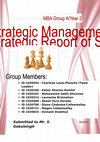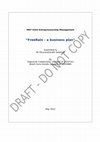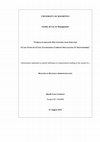Papers by Akash GURA GOREDO
EU is a successful model for economic cooperation, based on giving itself means for setting up in... more EU is a successful model for economic cooperation, based on giving itself means for setting up institutions for upholding its internal rules and remaining flexible enough for accommodating special cases and demonstrating solidarity with its less-able members. However, the RTA's in which Mauritius is a member currently focus on EU's strategy of building around trade, and remains only a mercantile approach, which is not sufficient. The Human Rights and human-centric approach are the guiding principles of the EU. Without this, and a focus beyond trade-only relationships, these RTA's will see the same fate as the former East-African Community.

The present document analyses the operating environment and the associated strategy adopted by th... more The present document analyses the operating environment and the associated strategy adopted by the SBM group, the second largest banking institution of Mauritius, in relation to the changes in the local and foreign environments that enabled it to remain profitable despite the recent global financial meltdown.
The opportunities and threats were analysed using the PESTEL framework for evaluating the various Political, Environmental, Social, Technological, Environmental and Legal parameters influencing the banking industry where SBM operates. It was found that the constraints to business expansion would come from the political, economic and legal areas, while social changes and technological advances were in fact opportunities for growth and consolidation of its position in the industry.
This was followed by an analysis using Porter’s 5 Forces model, where it was found that Competitive Rivalry was only a facade, that the Threat of New Entrants was real, but of no major consequence in terms of market share, that Bargaining Power of Suppliers was virtually inexistent as much as Bargaining Power of Customers and that there was also very low Threat of Substitutes, to conclude that SBM was operating in a duopolistic market at maturity stage.
SBM’s Internal Environment was analysed by examining its Key Success Factors, and identifying its Strengths and Weaknesses which would explain its existing strategies: Diversification strategy and Focussed differentiation.
Challenges facing SBM were analysed by identifying Opportunities and Threats in its external environment.
By combining the challenges and the key success factors (Strengths and Weaknesses against Opportunities and Threats: SWOT), three strategies were identified and proposed for pursuit in order to sustain SBM’s competitive advantage: Related Diversification Strategy, whereby an array of banking products and services were to be designed for adapting to the changing customer needs, Market development strategy in order to broaden customer base and maximise profits, and Focused Differentiation Strategy in order to propose innovative products that are unmatched by competitors
Sukuk is a novel financial product which appeals to most organizations and individuals having the... more Sukuk is a novel financial product which appeals to most organizations and individuals having the means to place relatively large sums of money over medium to long terms with the objective of reaping higher-than-normal yields at maturity. This way of mobilizing funds locally for implementing large-scale infrastructure is sustainable because its system of rewarding its subscribers does not rely on speculation, which as per the recent turmoil – originating from the credit crunch resulting from crash in the sub-primes market in the USA since 2008 – carries the risk of making assets toxic. However, only an intensive information campaigns focusing on its numerous advantages will reduce ignorance and develop confidence in the versatility of the product.

The present document is an intrapreneurship proposal for reducing significantly the water consump... more The present document is an intrapreneurship proposal for reducing significantly the water consumption of selected domestic households by building customised rainwater collection systems. The value proposition for the client is to generate sufficiently high volumes of usable water from rain with the intention of significantly reducing water bills and sustaining a sufficiently large stock for drought periods. The business intention is to create a wholly-owned subsidiary business unit, called “FreeRain”, operating with the existing resources of Sotravic Ltée in order to contribute profitable revenue and at the same time formalise the training process of direct labour – specifically pipe layers – within the company. The business venture will be operated from the head office of Sotravic itself, and will cover all the sites where the company is awarded the construction of reticulation (water or sewerage) networks.

“FOREIGN LABOUR IN THE PCONSTRUCTION INDUSTRY A CASE STUDY IN A CIVIL ENGINEERING COMPANY SPECIALISING IN TRENCHWORKS”, Aug 31, 2012
Abstract
The present study focuses on the case of Sotravic Limitée, a trenching and pipe works s... more Abstract
The present study focuses on the case of Sotravic Limitée, a trenching and pipe works specialist, which banked on a newly awarded large-scale construction project for growth. For this, Sotravic had to hire in sufficient numbers to be able to pursue expansion of its site operations, but despite high unemployment rates in the country, its attempts at attracting and recruiting locally remained unsuccessful and tried to hire migrant workers from a few nearby countries before finally securing a continuous stream of workers from India. This initiative allowed Sotravic’s construction activities to be pursued at a larger scale. While focussing on growth no study was made to assess whether this venture was worth the effort and if reliance on foreign labour can be sustained.
After collating data about site operations over time and analysing these by comparing productivity of local workers to foreign workers, it was found that the latter had higher attendance rates than local counterparts, but that absenteeism among them would increase significantly as soon as they were entitled to paid leaves. At site level, the productivity level of foreign workers was found to be significantly higher than that of local workers, especially in work items that required less intense physical effort such as pipe laying and installation of plastic chambers – also, this was achieved by a more intensive use of support resources surrounding their main task. However, local workers showed more dexterity in operating excavation equipment and concreting works, resulting in higher productivity in these work items.
It can be concluded from the analysis that it is worthwhile to hire expatriate workers in order to fill a demand gap in the short term and for specific, low-impact tasks such as pipe laying and installation of inspection chambers.







Uploads
Papers by Akash GURA GOREDO
The opportunities and threats were analysed using the PESTEL framework for evaluating the various Political, Environmental, Social, Technological, Environmental and Legal parameters influencing the banking industry where SBM operates. It was found that the constraints to business expansion would come from the political, economic and legal areas, while social changes and technological advances were in fact opportunities for growth and consolidation of its position in the industry.
This was followed by an analysis using Porter’s 5 Forces model, where it was found that Competitive Rivalry was only a facade, that the Threat of New Entrants was real, but of no major consequence in terms of market share, that Bargaining Power of Suppliers was virtually inexistent as much as Bargaining Power of Customers and that there was also very low Threat of Substitutes, to conclude that SBM was operating in a duopolistic market at maturity stage.
SBM’s Internal Environment was analysed by examining its Key Success Factors, and identifying its Strengths and Weaknesses which would explain its existing strategies: Diversification strategy and Focussed differentiation.
Challenges facing SBM were analysed by identifying Opportunities and Threats in its external environment.
By combining the challenges and the key success factors (Strengths and Weaknesses against Opportunities and Threats: SWOT), three strategies were identified and proposed for pursuit in order to sustain SBM’s competitive advantage: Related Diversification Strategy, whereby an array of banking products and services were to be designed for adapting to the changing customer needs, Market development strategy in order to broaden customer base and maximise profits, and Focused Differentiation Strategy in order to propose innovative products that are unmatched by competitors
The present study focuses on the case of Sotravic Limitée, a trenching and pipe works specialist, which banked on a newly awarded large-scale construction project for growth. For this, Sotravic had to hire in sufficient numbers to be able to pursue expansion of its site operations, but despite high unemployment rates in the country, its attempts at attracting and recruiting locally remained unsuccessful and tried to hire migrant workers from a few nearby countries before finally securing a continuous stream of workers from India. This initiative allowed Sotravic’s construction activities to be pursued at a larger scale. While focussing on growth no study was made to assess whether this venture was worth the effort and if reliance on foreign labour can be sustained.
After collating data about site operations over time and analysing these by comparing productivity of local workers to foreign workers, it was found that the latter had higher attendance rates than local counterparts, but that absenteeism among them would increase significantly as soon as they were entitled to paid leaves. At site level, the productivity level of foreign workers was found to be significantly higher than that of local workers, especially in work items that required less intense physical effort such as pipe laying and installation of plastic chambers – also, this was achieved by a more intensive use of support resources surrounding their main task. However, local workers showed more dexterity in operating excavation equipment and concreting works, resulting in higher productivity in these work items.
It can be concluded from the analysis that it is worthwhile to hire expatriate workers in order to fill a demand gap in the short term and for specific, low-impact tasks such as pipe laying and installation of inspection chambers.
The opportunities and threats were analysed using the PESTEL framework for evaluating the various Political, Environmental, Social, Technological, Environmental and Legal parameters influencing the banking industry where SBM operates. It was found that the constraints to business expansion would come from the political, economic and legal areas, while social changes and technological advances were in fact opportunities for growth and consolidation of its position in the industry.
This was followed by an analysis using Porter’s 5 Forces model, where it was found that Competitive Rivalry was only a facade, that the Threat of New Entrants was real, but of no major consequence in terms of market share, that Bargaining Power of Suppliers was virtually inexistent as much as Bargaining Power of Customers and that there was also very low Threat of Substitutes, to conclude that SBM was operating in a duopolistic market at maturity stage.
SBM’s Internal Environment was analysed by examining its Key Success Factors, and identifying its Strengths and Weaknesses which would explain its existing strategies: Diversification strategy and Focussed differentiation.
Challenges facing SBM were analysed by identifying Opportunities and Threats in its external environment.
By combining the challenges and the key success factors (Strengths and Weaknesses against Opportunities and Threats: SWOT), three strategies were identified and proposed for pursuit in order to sustain SBM’s competitive advantage: Related Diversification Strategy, whereby an array of banking products and services were to be designed for adapting to the changing customer needs, Market development strategy in order to broaden customer base and maximise profits, and Focused Differentiation Strategy in order to propose innovative products that are unmatched by competitors
The present study focuses on the case of Sotravic Limitée, a trenching and pipe works specialist, which banked on a newly awarded large-scale construction project for growth. For this, Sotravic had to hire in sufficient numbers to be able to pursue expansion of its site operations, but despite high unemployment rates in the country, its attempts at attracting and recruiting locally remained unsuccessful and tried to hire migrant workers from a few nearby countries before finally securing a continuous stream of workers from India. This initiative allowed Sotravic’s construction activities to be pursued at a larger scale. While focussing on growth no study was made to assess whether this venture was worth the effort and if reliance on foreign labour can be sustained.
After collating data about site operations over time and analysing these by comparing productivity of local workers to foreign workers, it was found that the latter had higher attendance rates than local counterparts, but that absenteeism among them would increase significantly as soon as they were entitled to paid leaves. At site level, the productivity level of foreign workers was found to be significantly higher than that of local workers, especially in work items that required less intense physical effort such as pipe laying and installation of plastic chambers – also, this was achieved by a more intensive use of support resources surrounding their main task. However, local workers showed more dexterity in operating excavation equipment and concreting works, resulting in higher productivity in these work items.
It can be concluded from the analysis that it is worthwhile to hire expatriate workers in order to fill a demand gap in the short term and for specific, low-impact tasks such as pipe laying and installation of inspection chambers.